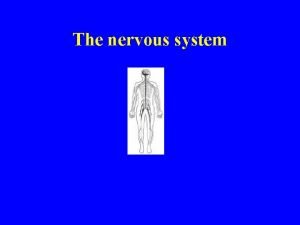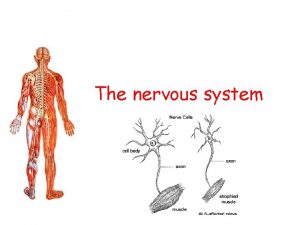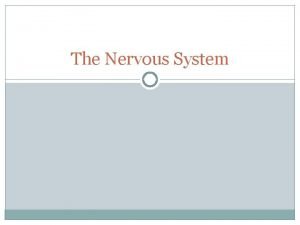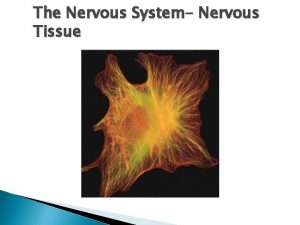The Importance of the Nervous System The Importance



















- Slides: 19

The Importance of the Nervous System

The Importance of the Nervous System Response to Change… • Adjustments made by electrochemical messages to & from the brain or by chemical messengers (hormones).

Vertebrate Nervous System Central Nervous System (CNS) • Nerves of the brain & spinal cord. Peripheral Nervous System (PNS) • Nerves between organs & the CNS. • Includes somatic & autonomic nerves.


Vertebrate Nervous System Somatic Nervous System • Controls skeletal muscle, bones & skin. Autonomic Nervous System • Control internal organs. • Includes sympathetic & parasympathetic nervous system.


Anatomy of a Neurons • Functional units of nervous system. • Includes sensory neurons, interneurons & motor neurons. Glial Cells • Non-conducting cells. • Involved with structural support & metabolism of neurons.

Anatomy of a Neuron

Anatomy of a Neuron Dendrites • Receives information. • Carries impulses toward cell body. Axon • Sends impulses away from the cell body toward other neurons and/or effectors.

Anatomy of a Neuron Myelin Sheath • Surrounds & insulates axons. • Formed by Schwann cells (glial cells). Nodes of Ranvier • Spaces between myelin sheath. • Nerve impulses “jump” from node to speed up rate of transmission.

Anatomy of a Neuron

Sensory Neurons • Known as afferent neurons. • Sense & relay info (stimuli) from the environment to the CNS.

Motor Neuron • Known as efferent neurons. • Relay information to the effectors (muscles, organs, glands).

Interneurons • • Known as association neurons. In brain & spinal cord. Integrate & interpret sensory stimuli. Connect afferent & efferent neurons.

Integration of the Different Neurons

Neuron Repair • Neurilemma is a thin membrane that surrounds some axons. • Promotes regeneration of damaged axons.

White vs. Grey Matter White Matter • Myelinated neurons in the CNS that contain neurilemma. Grey Matter • Non-myelinated neurons in the CNS that lack myelin and neurilemma.

Neural Circuits & Reflexes Reflex Arc • Stimulus receptor sensory neuron interneuron (spinal cord) motor neuron effector • Involuntary & unconscious.

Reflex Arc
 Neural circuits the organization of neuronal pools
Neural circuits the organization of neuronal pools Nervous
Nervous What are neuron processes
What are neuron processes Nervous system and digestive system
Nervous system and digestive system Endocrine system and nervous system
Endocrine system and nervous system Endo crine gland
Endo crine gland Endocrine system and nervous system
Endocrine system and nervous system Chemical messengers of the nervous system
Chemical messengers of the nervous system Platyhelminthes vs nematoda
Platyhelminthes vs nematoda The nervous system is made up of
The nervous system is made up of Three basic functions of the nervous system
Three basic functions of the nervous system Learning objectives of nervous system
Learning objectives of nervous system Bipolar neuron function
Bipolar neuron function Stimulus in nervous system
Stimulus in nervous system Nervous system objectives
Nervous system objectives Autonomic nervous system visceral
Autonomic nervous system visceral Nervous system def
Nervous system def Plexuses
Plexuses Sns pg
Sns pg The nervous system brain scienstructable
The nervous system brain scienstructable





































